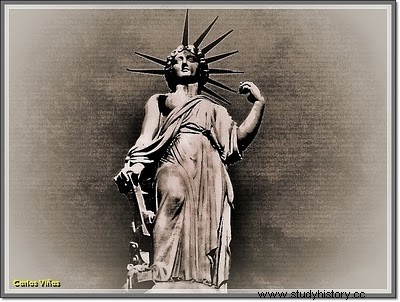The Statue of Liberty (Statue of Liberty ), is one of the most famous landmarks in New York, the United States, and around the world. It is located on Liberty Island south of Manhattan Island, next to the mouth of the Hudson River and near Ellis Island. The Statue of Liberty was a gift from the French to the Americans in 1886 to commemorate the centennial of the United States Declaration of Independence and as a sign of friendship between the two nations. It was inaugurated on October 28, 1886 in the presence of the American president of the time, Grover Cleveland . The statue is the work of the French sculptor Frédéric Auguste Bartholdi .

On February 18, 1879, Bartholdi registered the patent in these terms:
A statue representing Liberty that illuminates the world:it consists of a dressed female character, with one arm raised, carrying a torch, while the other holds an engraved tablet, and with a diadem on her head. The face has classic features, but serious and calm, with the body slightly bowed on the left side so that the leg on that side keeps the whole in balance […] Its reproduction is prohibited by any procedure known in sculptural art, under in the form of a statue or statuette, in high or low relief, in metal, terracotta, stucco de Paris or any other plastic compound.
In 1855, a little more than 30 years earlier if we take into account the inauguration date, we already had our Statue of Liberty - the work of Zaragoza native Ponciano Ponzano (1813-1877) – with… too many similarities .

In 1853 Ponzano was commissioned to create a statue to crown the pantheon of three illustrious liberal politicians:Agustín Argüelles, Juan Álvarez Mendizábal and José Calatrava. About two meters high, it is made from a block of Carrara marble roughened by the Genoese Tito Nicoli and in the words of the artist:
Liberty will be gallant, young, lightly dressed, she will cover her head with a Phrygian cap, giving off rays of light that will come out from her noisy hair [...] in her right hand she will show that she has broken a yoke -symbol of submission- that she will step on with the foot, giving the other leg greater support function [...] In the other hand he will carry a scepter.
[As a touch of humor, and to give more strength to the idea of freedom, Ponciano placed a cat next to the right foot]
Today it can be seen in the Pantheon of Illustrious Men from Madrid. When Ponciano passed away, he was so poor that the Real Academia de San Fernando he had to make an economic contribution -disguised as a purchase of drawings- to be able to bury him... Now, each one who draws his own conclusions .
